I can 100% relate when it comes to worrying about your horse’s health, especially when something totally unexpected starts happening like patches of your horse’s hair coming out! You suddenly start asking all your equine friends if they know what could be going on and Googling “Why does my horse have bald spots?” in 10 different ways.
When this kind of thing happens to me, I start worrying about a million things at once:
- Is it something dangerous? Is my horse going to be okay?
- Is it painful or irritating?
- Is it contagious?
- Is it my fault? Did I do something wrong?
- Is it permanent?
- Is this vet bill going to cost me a fortune?
Thankfully for your horse and your nerves, hair loss in horses actually might not be as big of a problem as you might think. But just to be sure, let’s go through some probable causes you can check for and fix yourself (or, of course, with the help of a vet).
This article contains affiliate links which means we may earn a commission if you decide to make a purchase.
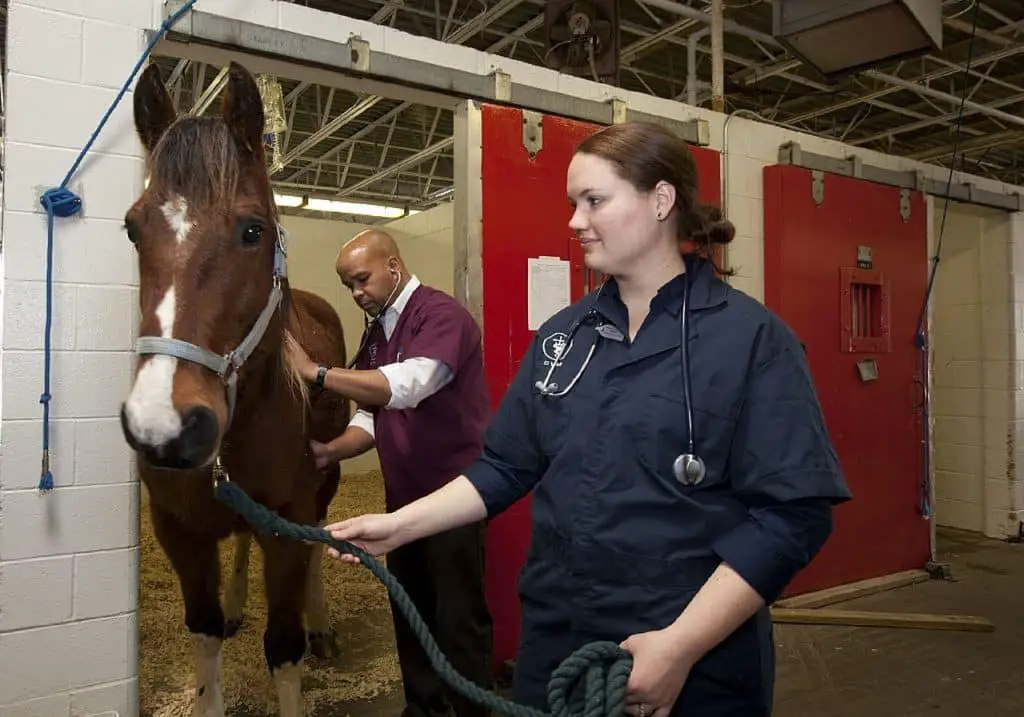
What Causes Bald Spots on Horses? (Causes of Alopecia)
The condition where your horse is missing patches of hair or having a difficult time with hair growth goes by the fancy medical term, “alopecia.”
This condition can be caused by a wide variety of things, some more serious than others. Here are some of the potential causes for horse owners to consider:
Cause #1: Seasonal Shedding
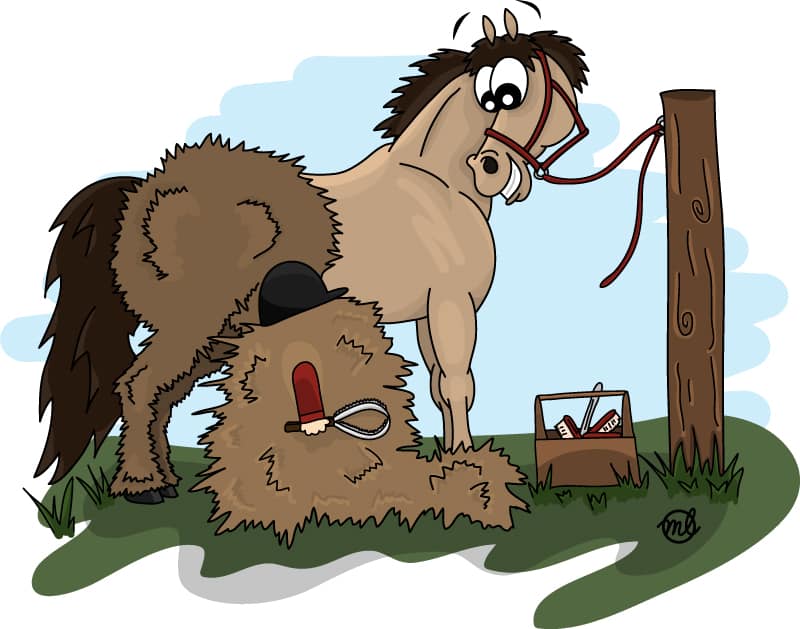
A very likely cause is simply springtime shedding! If you notice that the bald spots are seasonal then it’s probably just your horse shedding its winter coat. This is not something you should generally be concerned about.
How to Fix It:
If your horse is shedding its coat unevenly, however, then you can try different things to try and fix it:
- Coat supplements (think omega-3 fatty acids).
- Routine grooming, but not over-grooming (here’s a refresher on how to groom your horse).
- Changing your horse’s shampoo or conditioner (here’s a refresher on how to bathe your horse).
Note: Sometimes seasonal bald spots, especially located in certain regions of your horse’s body, can also be related to a melatonin issue if the pineal gland is overly active. It has been suggested that this may be due to fluorescent and other artificial lighting in the winter months.
#2: Rubbing from Equipment
Another very common cause of hair loss in horses is from sores caused by the equipment you’re using.
To use my dad as an example… He always wears those standard socks that cover his ankles and the lower part of his shin/calf. He’s been wearing them that way as long as I can remember (even with sandals and shorts…). And he now has significantly less hair where his socks sit, especially at the back of his leg.
The material has actually worn off the hair!
The same thing can happen to your horse. A consistently worn blanket might rub them in certain spots. Their saddle pad may not protect them properly from the saddle. Or even frequent wearing of a halter could be to blame.
Anything that consistently rubs the same spot has the potential to rub away their coat.
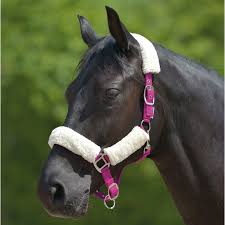
How to Fix It:
You can easily fix this hair loss root cause by getting a different saddle pad, blanket, or halter specifically designed to prevent rubbing. Or in terms of things like a halter, you can simply not use one when your horse is stalled (unless there is a specific reason to use it).
Cause #3: Bitting, Kicking, & Injuries
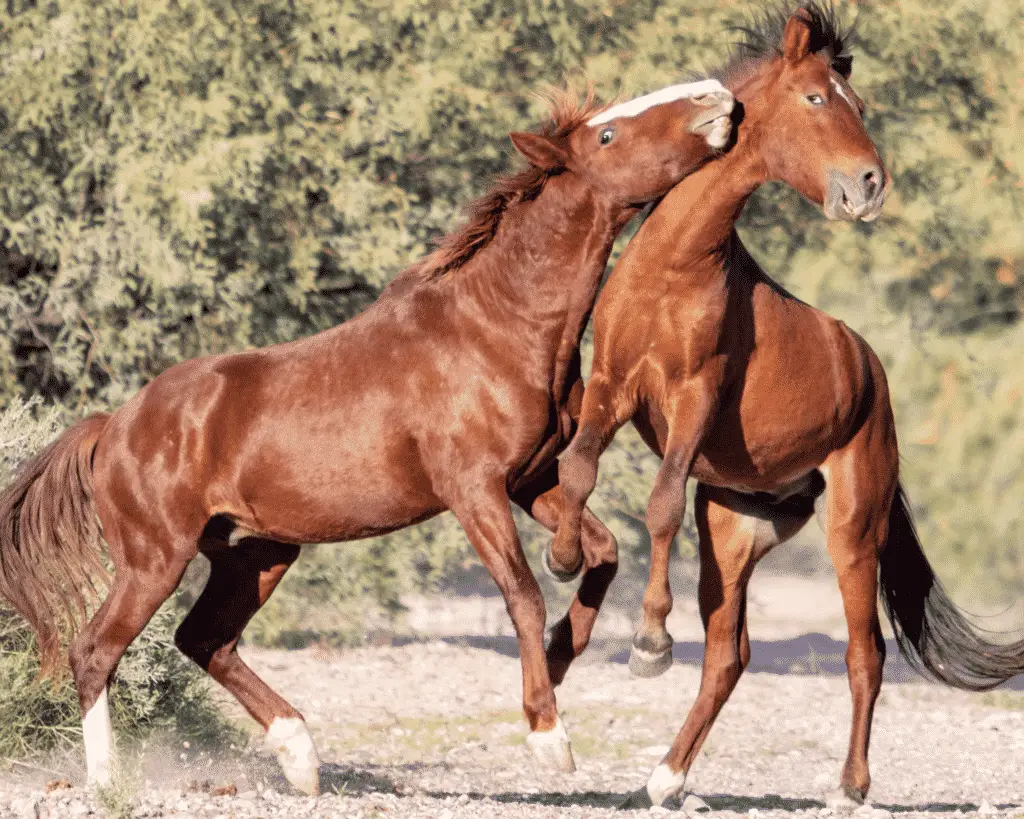
Another common cause of Alopecia is injuries. If your horse has been injured then (just like humans), they’re likely to scar. The skin and surrounding hair around the injury may not grow back.
How To Fix It:
You can’t really fix bald spots due to injury; it’s simply how the skin heals. However, as a horse owner, you can take steps to try and prevent your horse from getting injured in the first place.
It can be difficult to prevent minor kicking and biting, especially when introducing a new horse into your home. This is a natural process to develop a hierarchy among the herd. But do watch for excessive aggression, and try to curb it.
Some horses that are overly aggressive need to be worked with and could benefit from separation from the rest of the horses until you can work through their issues.
Furthermore, another thing you can do is make sure that there are no areas of your fencing that are sharp or sticking out. Your horse may have tried to scratch or got close to a sharp piece by accident and cut themselves instead.
Cause #4: Selenium Toxicity
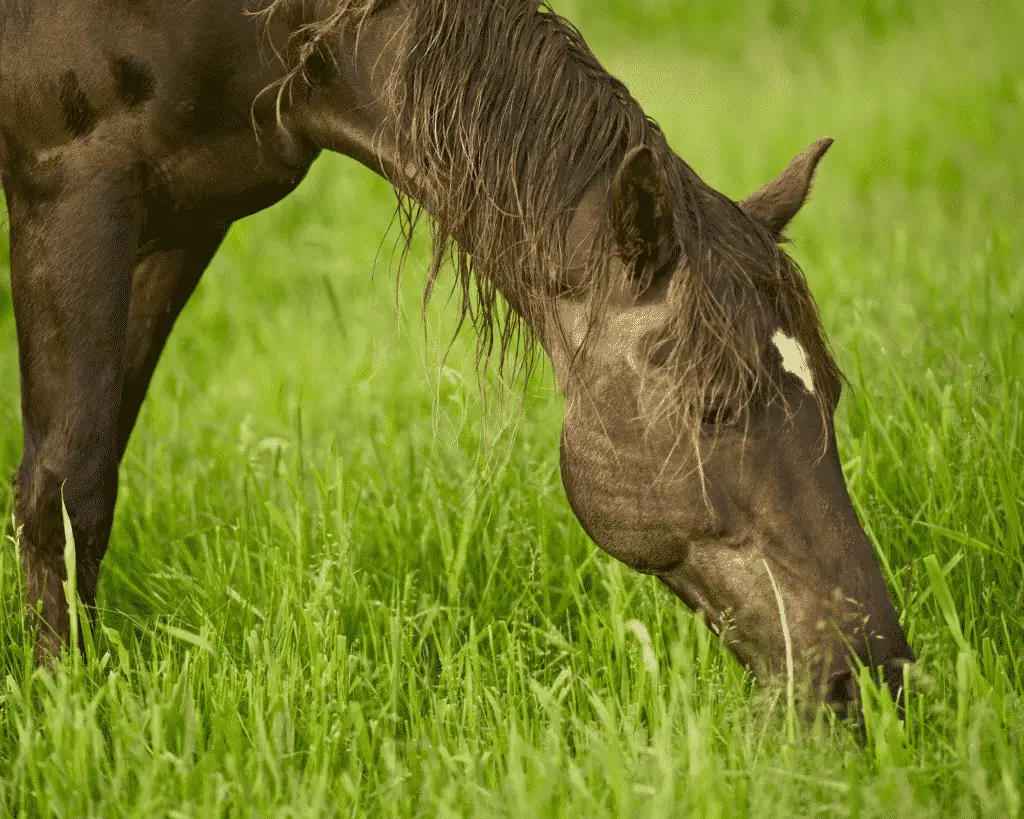
Although it’s rarer than the previous reasons, another cause could be that there is something in your horse’s diet that’s causing hair loss. Here is an in-depth article with pretty much everything you need to know about selenium toxicity vs. deficiency. But here’s the short of it:
How to Fix It
First, you may want to try changing the feed for the affected horse to see if it makes a difference in the amount of hair loss.
However, it might not be the result of the feed, but rather what your horse is eating in the fields.
Selenium is a chemical that is present in a variety of plants and chances are, your horse eats is pretty frequently. (In fact, it’s actually essential for healthy horses’ immune and fertility function, among other things!)
Problems can arise, however, if your horse starts eating too much. If there are plants accessible to your horse that are very high in selenium content, they could develop poisoning.
One of the symptoms of selenium poisoning is hair loss especially of the mane and tail (as opposed to the hair follicles on the horse’s coat). Other symptoms to look for include fear and nervousness at first and then weakness, diarrhea, fever, loss of appetite, and respiratory distress.
Another very indicative sign of selenium poisoning is hoof cracking and deformities.
So if you notice severe horizontal cracks in your horse’s hooves, like the above, call your vet immediately. Acute selenium toxicity can be extremely dangerous.
Below are some plants that require a high selenium content in the soil to grow (from igrow.org). You can do a sweep of your pastures to see if there are big sections of any of them around.
You may also want to do a quick Google search to see if selenium poisoning is common in your area. (Along the stretch of the Rocky Mountains and slightly east of them are the most commonly affected areas in North America.)
Cause #5: Gnats

If you’ve ruled out everything above, then try observing your horse closely for the next few days. Are they biting at and itching against anything they can find? If so, the hair loss could be a result of insect bites.
There’s actually a fancy name for this excessive itching as well, and it’s called “pruritus.”
Think of dog fleas. On horses, instead of fleas, you get gnats. It’s also important to note that some horses may be more sensitive to the bites than others.
How to Fix It:
To try and keep your horse away from insect bites as much as possible, try turning them out at a different time of day or get some insect repellent for them.
Or, here’s a video promoting a homemade remedy. (I don’t have any experience with this homemade product so I’m not recommending or advising against it. I just think this is a nice video to show you what the effects look like.)
Cause #6: Mange
This is extremely unlikely for your horse to have if you live in North America. It’s basically an infestation of tiny insects called mites that burrow deep into your horse’s skin and are thus very hard to detect.
All you can do is call your vet for treatment options. But I would recommend giving your horse a big treat because they’re probably in a lot of discomfort!
To read our in-depth guide all about the different kinds of mange, prevention, symptoms, and more, see this article.
Cause #7: Lice
Yes, unfortunately, your horse can get lice just like you can! This could be yet another cause of hair loss if your horse is itching a lot due to the lice.
Lice especially like to live on horses with thicker, longer hair, like draft horses. You can spread apart your horse’s hair to look for lice; you’ll be able to see them moving around if you’re attentive. The image above was obtained from pet-informed-veterinary-advice-online.com.
And don’t worry—the lice variety that are most likely to infect horses are actually equine-specific, so they’re not likely to infect you.
How to Fit It:
In order to treat this, you’ll need to get into the same disciplined regimen you might have had to do for yourself back in grade school. You’ll want to bathe your horse with lice shampoo and thoroughly disinfect all of your brushes, blankets, and other tack. Be very careful to make sure nothing that could be contaminated comes into contact with your horse for the next several weeks.
Cause #8: Rain Rot or Scald
The more serious conditions are also the ones that are the most unlikely, especially if you take care of your horse well. However, there are some potentially concerning things that could be causing your horse’s hair loss, and it’s important to get an accurate diagnosis. (If you suspect one of these, it’s time to call the vet pronto.)
Rain rot is a skin infection most often caused by consistent exposure to excess moisture. This can happen if a horse is left outside in rainy or wet conditions for too long without stall time, grooming, or a blanket.
In the case of rain rot, the horse is infected with an organism (which behaves like a mix of bacteria and fungus) called dermatophilus congolensis. One of the symptoms of this is that your horse may start to lose hair in patches.
Above is an example photo (from caribuhorsewear.com.au).
Usually, keeping your horse clean and dry can solve the issue, but if it’s a severe infection, then antibiotics and/or topical anti-fungal ointments may be needed.
You can read more about rain rot here.
How to Fit It:
- Call your vet.
- Keep your horse dry:
- Scrape off water after bathing.
- Provide shelter if it rains or stall them more.
- Invest in a light, breathable but waterproof blanket (check out my review on WeatherBeeta’s blankets).
- Keep your horse clean:
- Shampoo with an antimicrobial shampoo.
- If you want to avoid chemicals, you can use silver-based products.
- Isolate your horse from other horses.
- Don’t ride your horse, especially if there are lesions on their back.
- Apply bug spray if needed.
- Be patient and give the new hair time to grow back
Cause #9: Ringworm
If your horse has a case of ringworm, you’ll see hair loss in patches and scaly, dry skin in its place in a ring-like formation. The image below is an example.
This infection is transferred from other animals such as cattle or other horses or even humans (although that’s very rare).
This is essentially a fungal infection and, if it’s minor, can be treated quickly and easily. If it’s more severe, then treatment may need to be more drastic, especially if there’s an underlying condition. Here is our in-depth guide all about ringworm prevention and treatment.
How to Fit It:
- Call your vet.
- Get rid of all hair near the area.
- Spot wash the affected area with an anti-fungal scrub.
- Apply anti-fungal cream.
- Apply anti-fungal dressing.
- Dispose of all clipped hair.
- Disinfect all equipment that came into contact with the horse.
- Wash towels, blankets, and any other textiles separately and with hot water.
- Wash yourself and all animals.
Again, you may need to be patient, but if you do the above, you should see an improvement within three to 12 weeks.
Cause #10: Sarcoid
This is usually a benign lesion or tumor. It’s essentially known as skin cancer for horses but it’s generally not systemically harmful. Its exact cause is unknown although there is some speculation that it can be transferred from cattle who have bovine papillomavirus (BVP).
The image above is just one example but sarcoid can look many different ways as it evolves.
In very rare cases, the tumor is not benign (it is malignant) and can transfer to the lymphatic system and invade the horse’s system. For this reason, you should once again call your vet for proper management and treatment. Your vet may give an over the counter treatment and will probably want to keep an eye on it.
You can read more in our in-depth guide to equine sarcoids right here.
Other Resources To Encourage Hair Growth and Restore Hair Follicles
In addition to what we’ve covered already, here are some last pointers to help you both prevent and deal with hair loss in your horse:
- Always make sure you’re doing proper and careful grooming (here’s how)
- As your horse’s skin heals and hair starts to grow back, use soft brushes on their coat and stay away from anything to harsh.
- Consider giving your horse a coat supplement like this one or this one
- Don’t ride your horse (or ride them less) while your horse is losing hair.
Horse Owners Should Not Hesitate to Call the Vet When Your Horse Has Hair Loss
I know I said it a lot throughout this post, but I can’t stress enough how important it is to implement professional veterinary medicine when it comes to horse hair loss.
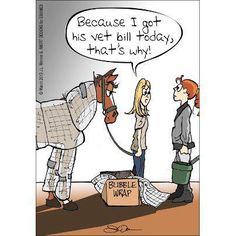
If you really can’t afford a vet or you don’t want to jump the gun on diagnosing your horse with something life-threatening when it’s actually nothing, then at least call someone you know who has had plenty of horse experience and has faced these types of problems themselves.
I really hope this has been helpful to you, and as always, don’t hesitate to comment below and share your experiences with everyone! Have you and your horse ever had to deal with any of these conditions before?
Hope to hear from you soon and happy riding!
Martina
Liked this post? Why not share it!

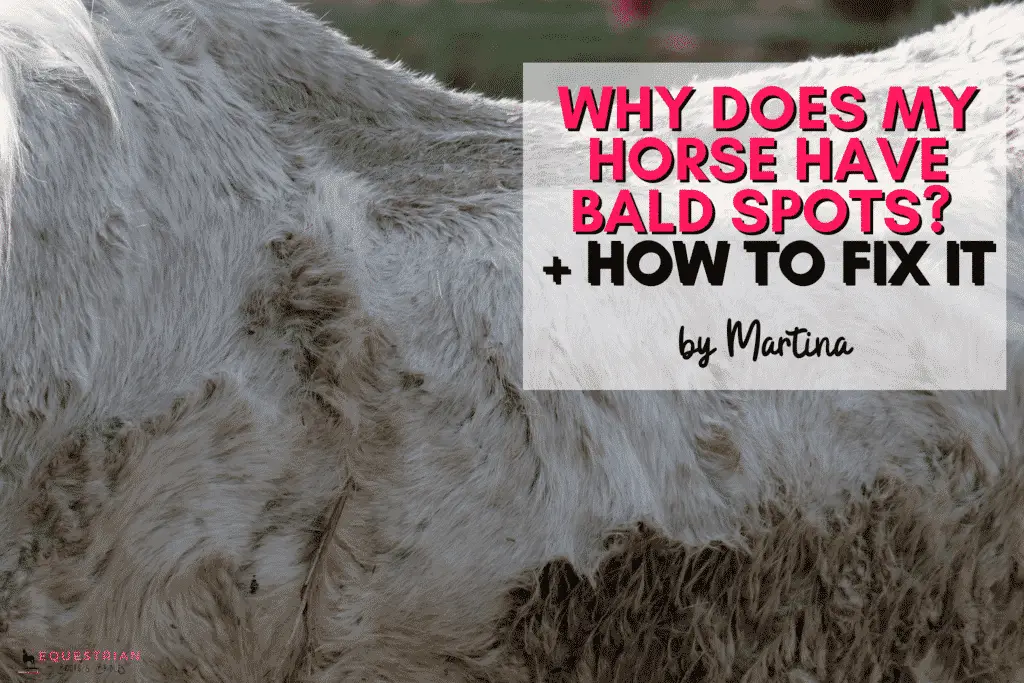

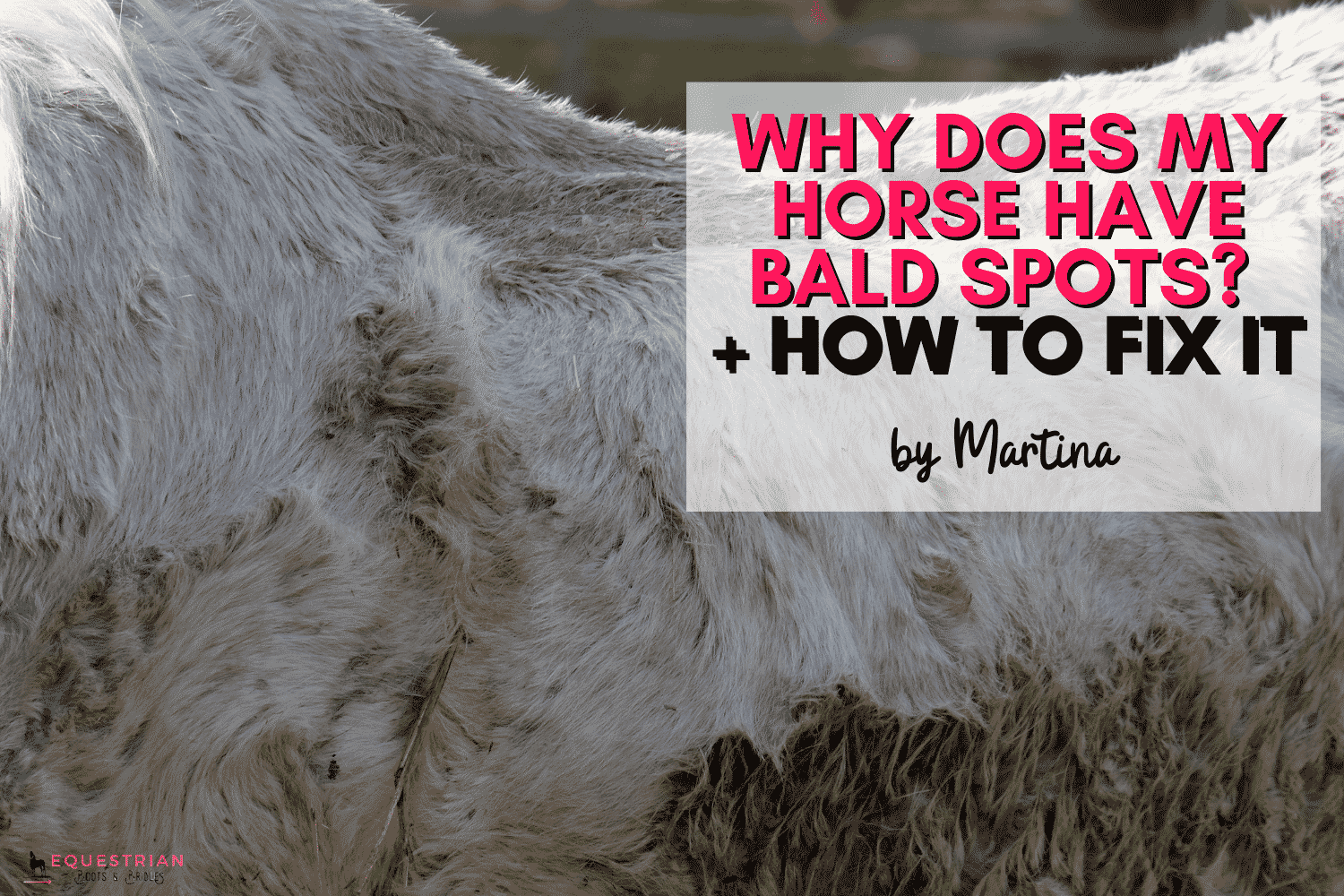

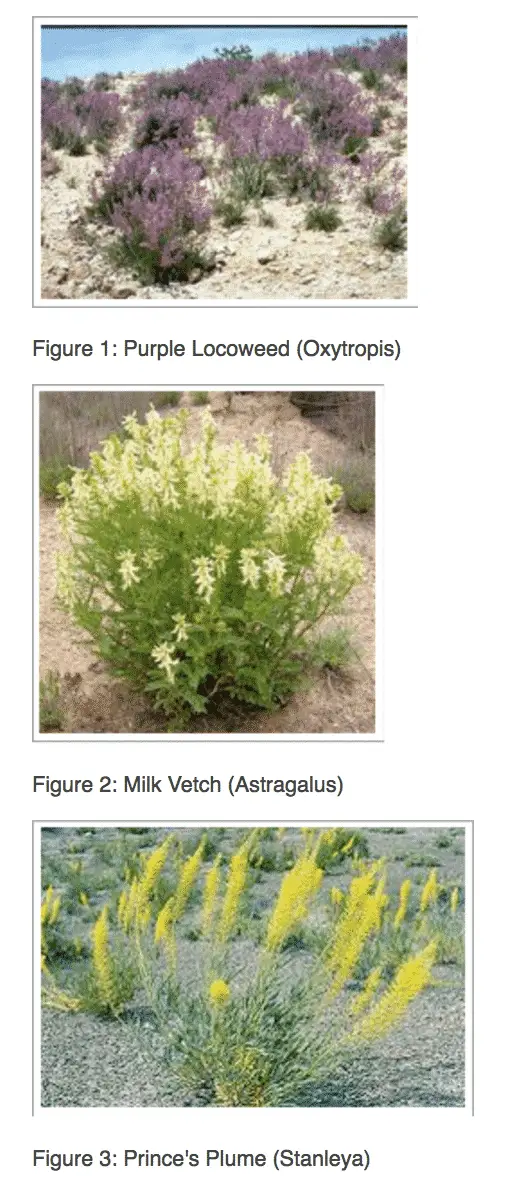
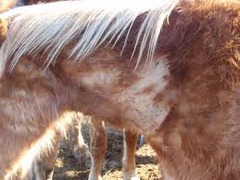

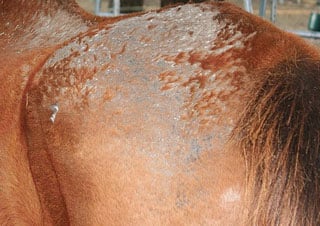
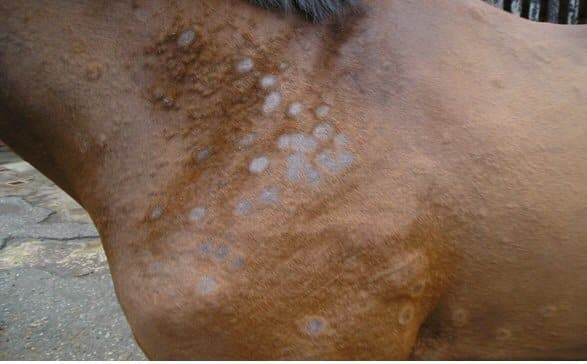
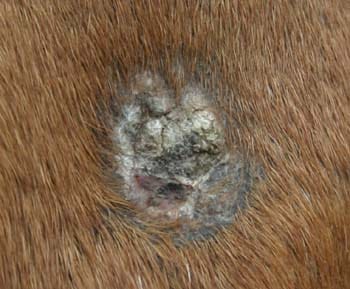
Thanks for this great information. I was very worried when my horse started showing bald spots but in the end it turned out to be just shedding unevenly. I did call the vet though because I didn’t want to take any chances. Now I can bookmark your website and use it as a resource for valuable information. Thanks so much! Hannah and Chance.
Hey Hannah,
So happy to hear that it was just shedding! Normally that is what it ends up being but us horse gals can’t help getting all worked up 🙂
And yes – good call, always best to call the vet just incase. No problem – let me know if ever have any other questions!
Thank you so much for providing a very useful guide on what causes the bald spots as well as how to deal with them. I just got my horse and I am trying to learn what should be done in order to properly take care of him. Prevention is better than cure but it also is equally important to know the cure as a lot of things is inevitable nowadays.
Hey Pitin!
I noticed you commented on my other post as well 🙂 Seems like you’re trying to brush up on your horse knowledge with your new buddy. That’s wonderful I really hope that everything goes as smoothly as possible with you two. Also yes prevention is key! So make sure to keep your horse dry, watch what he’s eating and don’t expose him too too much to insects if you can help it. Also keep him away from cattle or chickens and other farm animals if you breed those
I think that I am going to wear socks permanently from now on then I won’t need to shave my legs lol.
We used to have horses on our farm but they lived outdoors and grazed on the fields. They were mostly wild. One of the older ones had bald patches here and there on the side of his tummy. We thought it was just old age. Nice to know there are other causes as well. Never thought of moulting, as thought they usually moulted evenly.
Hi Michel!
I’ve tried – unfortunately it takes far too long haha
Some horses tend to shed in patches, especially during the springtime. Although they don’t completely display “bald spots” as they appear when an infection is present (you may not actually see the skin – although in some cases you can), they still can have a patchy appearance that seem like bald spots. This is the most common out of all the other causes I mention above! Also, as I mentioned certain light sources have been speculated to be the cause of patchy shedding (which would most likely show up in the winter) but this would then be a health issue related to melatonin.
Thanks for this! A few weeks ago I was really worried when my Quarter mare started to have a few bald spots, I had her checked for parasites and she came back clear. It turned out she was rubbing on the fabric gate because she was itchy with bug bites, but I couldn’t get her to stop itching! Luckily, my friend had a jar of this stuff called coat defense, she swore by it so I thought, why not? It worked PERFECTLY! Not only did she stop itching, but the hair was back within’ a week! If anyone has any of the issues listed above, be sure to give them a try!
https://www.coatdefense.com/products/
Hey Anne,
Thanks for the recommendation 🙂
Yes, chronic itching in the same spots can definitely cause bald patches and you gotta make sure your horses stops to keep them from becoming permanent.
I found your post on why horses develop bald spots and how to address them quite informative and helpful. It’s essential for horse owners and enthusiasts to understand the potential causes behind these hair loss issues and the steps they can take to promote healthy skin and hair growth.
One particular factor that can contribute to bald spots on horses is the presence of hot spots or excessive sweating. When a horse becomes a hot horse and sweats excessively, it can lead to skin irritation and hair loss in localized areas. This can be a result of various factors such as intense exercise, high temperatures, or underlying health conditions.
To address hot spots and prevent further hair loss, it’s crucial to identify and address the underlying causes. Regular grooming practices, such as keeping the horse’s coat clean and free from dirt and debris, can help reduce the risk of skin irritation. Additionally, ensuring proper ventilation in stables and providing adequate shade and water during hot weather conditions can help minimize sweating and overheating.